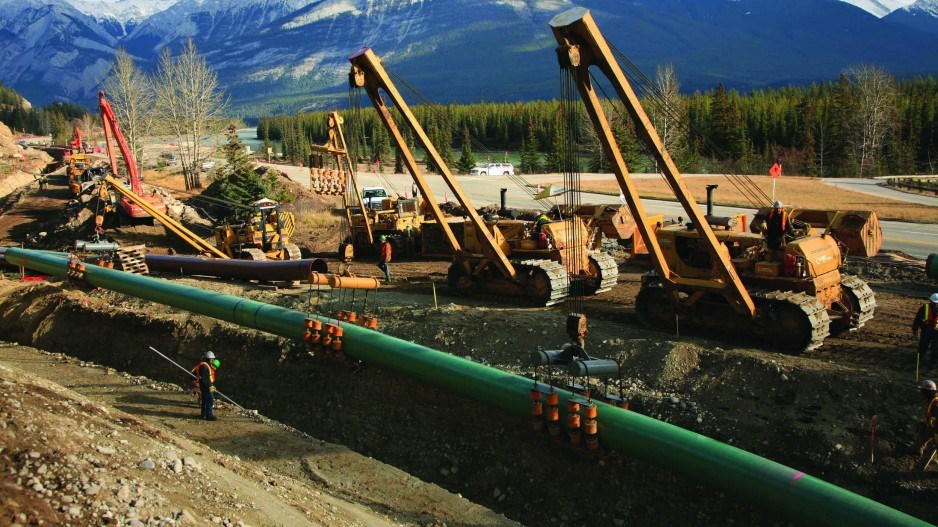When Enbridge (TSX:ENB) volunteered to improve oil tanker safety measures for its doomed Northern Gateway pipeline project, it might have set a precedent of expectations – and obligations – for the Kinder Morgan Canada (TSX:KML) Trans Mountain pipeline expansion.
The spectre of one pipeline project setting a precedent, and adding regulatory scope, for another was raised by a Federal Court of Appeal judge last week.
Five First Nations, two environmental organizations and the cities of Burnaby and Vancouver are part of a consolidated appeal of the federal government’s approval of the $7.4 billion pipeline expansion project.
In an eight-day hearing that began October 2, they have argued that the National Energy Board (NEB) failed to properly consider the environmental impacts of increased oil tanker traffic, contrary to the Canadian Environmental Assessment Act (CEAA).
The expanded pipeline would increase monthly oil tanker traffic through Burrard Inlet to 34 from five. Environmental groups have raised concerns that noise from that increase could have a deleterious impact on resident southern killer whales.
But Kinder Morgan Canada neither owns nor controls oil tankers. Nor is the NEB responsible for marine shipping, which is regulated by Transport Canada, the Canadian Coast Guard and the Canada Shipping Act. In both the Northern Gateway and Trans Mountain environmental reviews, the NEB restricted its scope to the pipeline and terminal operations.
But in Northern Gateway’s case, a voluntary commitment became obligatory when Enbridge agreed to go above and beyond what was required. It also agreed to additional marine shipping safety measures.
A joint NEB and Environment Canada review panel took those voluntary commitments and made them part of the 209 conditions when the project was approved.
The question now is whether the NEB should have taken that as a template for the Trans Mountain expansion project and included marine shipping as part of its environmental review of the expansion project.
During Trans Mountain’s October 10 submissions, Justice Eleanor Dawson said the NEB had been “far more proactive” on the tanker traffic issue in the Northern Gateway pipeline project than it had been on the Trans Mountain expansion.
“We have the board declining jurisdiction and relying, at least in part, on its inability to impose conditions and on the fact Trans Mountain didn’t own the tankers,” Dawson said of the NEB’s assessment of the Trans Mountain pipeline expansion.
And yet, as she pointed out, in the Northern Gateway case, the NEB, as part of the joint review panel, agreed to conditions that were supposedly outside its scope when the joint review panel decided to make Enbridge’s voluntary commitments actual conditions.
“The point is: to what extent is the position of the NEB in that project relevant to the marine shipping issues that are raised in this case?” Dawson asked.
Trans Mountain’s lawyer, Maureen Killoran, answered that the scoping of the two reviews were different.
Whereas the joint review panel was just that – a joint process involving the NEB and Environment Canada – the NEB alone was responsible for the Trans Mountain expansion environmental assessment, thanks to a streamlining of the CEAA in 2012 that allowed a single regulatory body to conduct environmental reviews.
“The scoping at that point, when [the] joint review panel was populated by other government [responsible authorities], that scoping may have made more sense in that setting,” Killoran said.
But Dawson concluded by suggesting the NEB did have the discretion to consider marine shipping as “incidental” to the pipeline project.
The Appeal Court also took up a point raised by the City of Burnaby, which questioned why, as part of its assessment, the NEB never considered alternative routes and terminus locations to the one chosen by Kinder Morgan.
It has been suggested, for example, that, as part of the review, alternative sites for a terminus – including Kitimat and Roberts Bank – should have at least been considered as part of the environmental assessment.
It has been argued that, because it is less densely populated than Burnaby, Delta’s Roberts Bank might be a better location for a marine terminal.
Although alternatives were not considered as part of the NEB review, Killoran said the company did explore Roberts Bank as an alternative, although the study it did was not part of the application or NEB review.
Killoran said a study of the Roberts Bank option determined that it would require a new marine terminal to be built (in addition to the existing Westridge Marine Terminal), 100 acres of land, a seven-kilometre trestle and 14 kilometres of additional pipeline – all of which would have added $1.2 billion to the project’s cost.
The study also identified issues over Tsawwassen First Nation treaty rights and environmental impacts. Ultimately, the company determined that option wasn’t economically feasible.




